2011 TSX and TSX Sport Wagon
 Tuesday, April 26, 2011 at 11:29PM
Tuesday, April 26, 2011 at 11:29PM 
For 2011, the TSX Sport Wagon makes it's debut, but the entire TSX lineup receives a number of upgrades designed to keep the car fresh and up-to-date. As is the normal practice, none of the sheetmetal changes, but there are are a number of improvements to the front and rear bumpers, wheels and interior. Under the skin there are engine modifications for improved fuel economy and reduced noise and vibration.
I'll review the changes for all 2011 TSXs and then spend a little time talking about the new Sport Wagon. All TSXs continue with 17 inch alloy wheels, but the old painted finish has been replaced with a new brushed aluminum finish. Up front, the controversial grill has been revised to 'tone it down' and the entire front facia has been cleaned up for a more cohesive appearance. The rear bumper has smaller changes, but there is a new chrome strip above the license plate.
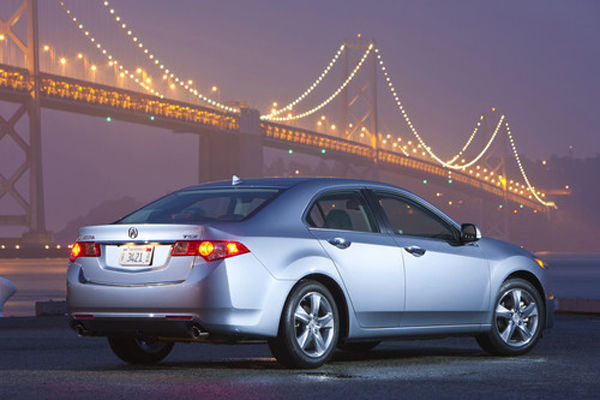
When you open the door, you're greeted with new contrasting stitching for the (standard) leather seats, and 'dressier' finishes on the door handles, center console and instrument panel trim. There are (finally) rear seat air conditioning vents for the rear seat passengers and in a new twist, another vent inside the center console. There is no way that the cooling air directed into the console would ever cool a warm drink, but it should be enough to keep a cool drink a little cooler.
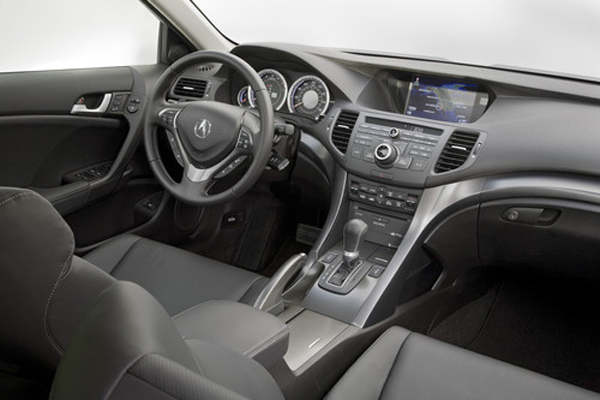
Technology Package TSXs now have the new display from the TL and MDX which features a higher definition screen for easier viewing. This also means that owners now have the Hard Disc Drive Navigation system that has faster response time, and an extra 15 Gb of storage for user MP3 files. As before, iPod and USB integration is standard but Tech Package cars get the new "Song By Voice" that allows you to select music (song, artist, playlist etc.) by voice control. Finally, the Back Up Camera now has guidelines to assist when parking.

Under the hood, there are revised versions of the 2.4 liter i-VTEC 4 cylinder and 3.5 liter VTEC V-6. These engines benefit from a number of changes to improve fuel efficiency. The TSX sedan with an automatic transmission is rated for 22/31/26 (city/highway/combined) by the EPA, an improvement of 1 mpg for each rating. The V-6 TSX does even better at 19/28/23 which represent +1 city, +1 highway but +2 combined.
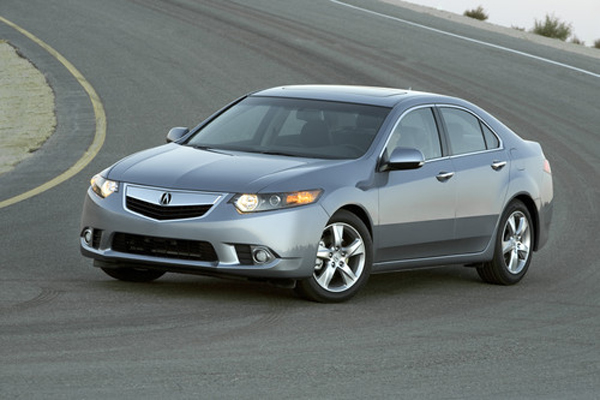
In an effort to improve the overall experience, the car now features acoustic glass for the front windshield, and new, thicker rear glass to help reduce wind noise. Floating suspension mounts, lightweight insulating materials and special separators in the windshield pillars also contribute to the quieter cabin.
TSX Sport Wagon
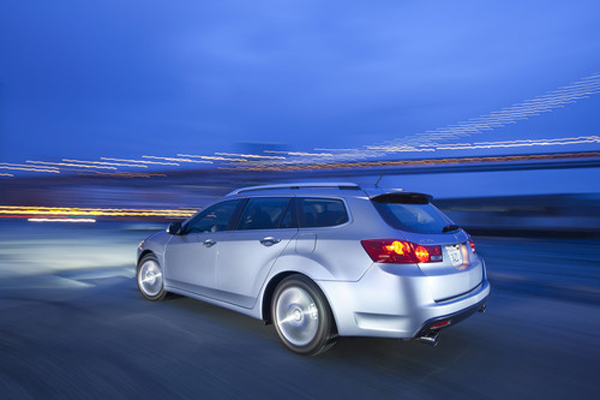
The addition of the TSX Sport Wagon should help buyers who desire more cargo carrying capacity than the sedans but don't want to move to the taller RDX or MDX. Being based off the sedan, it benefits from the same balanced approach that makes the TSX sedan such a success. Available in limited numbers, this is offered in two trim levels (TSX and Tech Package) but with only one engine and transmission choice; the same 2.4 liter iVTEC engine from the sedan. This package provides peppy around town performance and nearly identical fuel economy as the sedan at 22/30/25.
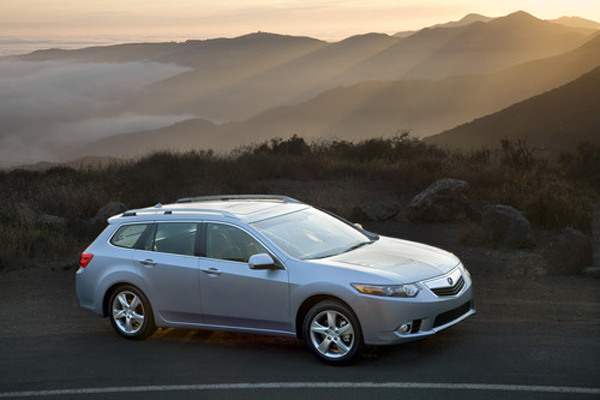
Dimensionally, the Sport Wagon is 189.2 inches long, about 4 inches longer than the sedan. This extra length improves interior space, allowing for 94.4 cu ft of total interior space with 25.8 cu ft behind the rear seats and more importantly, 60.5 cu ft with the seats folded. There are convenient storage cubbies under rear floor, and on the sides of the spare tire. With a low lift-over height of about 24-inches, loading heavy items is simplified. For increased security, standard is a retractable cover that prevents rear cargo items from being seen should a passer-by look into the rear windows. If you opt for the Technology Package, you'll have access to the cargo area from a remote linked power lift gate.
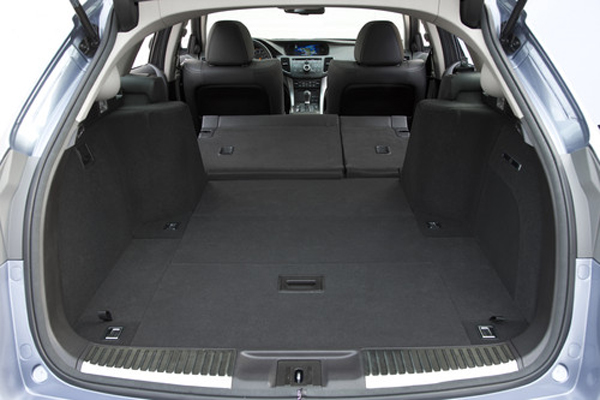
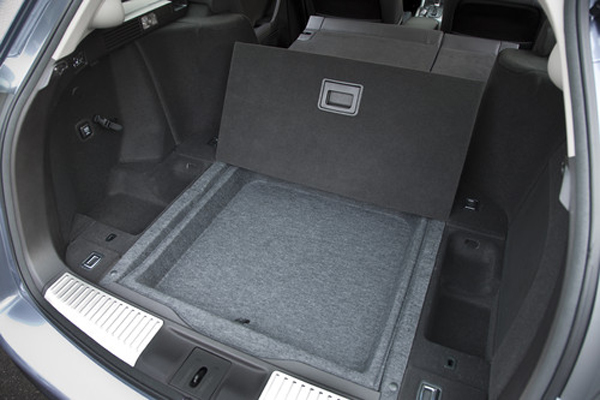
On the road, the Wagon and revised Sedan feel more composed than the '09-'10 cars, something reinforced by the (newly) quite cabin. Wind noise has been noticeably improved, and there even seems to be less tire noise in the cabin. The steering also feels better, with a more 'connected' feel than the earlier cars. The Electronic Power Steering (EPS) is still very light, but it feels less 'darty' and seems to communicate what the front wheels are doing better. I think we're seeing the benefits of Acura staying with a Double Wishbone suspension vs MacPhereson struts like many competitive wagons use. (including, BMW and Volvo wagons).
Many people will question if the 2.4 liter 4 cylinder has enough power to move this ~3600 pound car. I think that most would be pleasantly surprised by the feel and eagerness of this engine. It propels the car from 0-60 in about 8 seconds, and could still deliver low 20's around town and easily upper 20's on the highway. All in all, an excellent trade off between performance and economy. In my opinion, if you need more performance, you should consider the RDX and it's turbocharged 240 horsepower engine. You'll have a similar 60 cu ft of seat down storage space but more power and torque (though sacrificing some fuel economy).
Overall, the TSX Sport Wagon offers great utility combined with a comfortable driving experience. Initial reviews have been pretty positive and you can see a few from the links below.
http://www.autoweek.com/article/20110419/CARREVIEWS/110419850
http://www.pressherald.com/life/wheels/going-back-to-the-future-in-acura-tsx-wagon_2011-05-08.html
http://www.motherproof.com/news-rants/story/2011-acura-tsx-sport-wagon-car-seat-check/
Production is expected to be around 4000 per year. With 12 months in a year and 270 Acura dealers, it's not hard to figure out that this will be in relatively short supply. Give me a call (808.255.1255) or drop me a note and we can schedule a test drive.
 2011,
2011,  Sport Wagon in
Sport Wagon in  TSX
TSX 
Reader Comments (4)
Colin, I'm a Honda enthusiast like you....going back to my '83 Prelude, and through to my current 2002 RSX (I still run your RSX review video in my iPhone rotation). The TSX wagon is very appealing, but for me, the showstopper is the lack of a 6-speed option.
You'll always hear industry executives say that "manuals don't sell" but obviously they eventually sell, but keeping a car 300 days waiting for the right buyer just sucks. In the end, you typically "give" the car away, the customer rarely gets their color choice, and the risk of lot damage goes up exponentially.
As a person who has NEVER bought an automatic, (also, my wife's last auto was in '84), I lament their demise as much as you do. However, as someone in the business, I can see why it is like that. FWIW, we still have a brand new 2010 SH-AWD TL with a 6MT (our last 2010 and as of today, it's 528 days old). So the relative lack of demand is one issue, the second is more practical; how do you build it?
Unless Honda changes their entire philosophy to allow for "special orders" there is no practical way to do a manual transmission on a car with a 4000 unit per year production cycle. At that rate, it's already only 1-2 cars per month, per dealer and this is with only two trim levels. Adding a manual with the normal expected take rate of 5-10% is only 200-400 cars per year, divide this by 270 dealers and 12 months and you get an idea why you'll never see it happen. -CS
I would perk up for an updated RSX, and the Honda Civic SI with its weird dash layout (can you say minivan?) is not that car. For those of us who really appreciate the Honda spirit, focused on the driving experience, a simple, logical instrument layout is worthwhile. In my mind, the driver compartment on most gens of the Prelude, the NSX, RSX and Integra are good examples of what I'm talking about.
But, getting back to manual trannies, how do BMW, Audi, et al seem to offer desirable models with a stick, considering the economic and logistical realities you stated above?
I suspect that they are able to do low volume manual transmissions because A) they charge more for the cars, passing on the added manufacturing costs to the consumer and B) they seem to have longer product cycles allowing them to amortize costs over a longer production run.
IMO, many of us are Honda/Acura enthusiasts because we like the high value they offer for the money. We can lose sight of the fact that they are (apparently) able to offer this value because they streamline the manufacturing process by limiting options.
We often hear the argument that goes something like, "I'd be willing to pay more if I could get [insert feature]". Unfortunately, my experience is that the general consumer has no idea how much additional cost is added when you lower the volume. Look no further than the V-6 TSX for an example of how much a relatively simple change must cost.
As a counterpoint, maybe the question we should be asking isn't, "why doesn't Acura give us a manual transmission?" But rather "why doesn't BMW or Audi sell their manual transmission cars fully equipped for $30,000?"